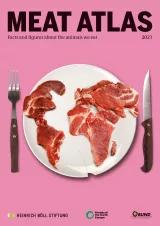
The world’s meat production has grown rapidly, fed by rising demand and made possible by technological advances
in livestock farming. But this has had serious consequences for animal welfare and small-scale producers.

For the first time since 1961, global meat production did not rise in 2019, but actually fell by 2 percent to 325 million tonnes. The main cause was not declining demand, but an outbreak of African swine fever. In China, this pig disease led to a 10 percent decrease in meat production, and over 20 percent less pork output.
Before the outbreak, China produced twice as much pork as the European Union and more than five times as much as the United States. Despite the slump in output, China remains the world’s biggest meat producer, at over 88 million tonnes a year, way ahead of the USA, the EU, Brazil and Russia.
Looking back, global meat production has grown rapidly over the past few decades. In the 1970s, it totalled just one-third of current levels. At that time, the EU and USA led the list of producers; however, they were overtaken by China by 1990. This country has boosted output more than tenfold in the last 50 years. Production in Africa has also quadrupled since the 1970s, but from a relatively low starting point. The continent now produces around 20 million tonnes of meat a year.
The increases in productivity over the last decades are mainly a result of technical innovations. Fewer and fewer animals are raised on pasture. A large proportion of meat comes from livestock kept indoors or on feedlots, where large numbers of animals are penned in a small outdoor area. Intensive and industrial management have increasingly replaced extensive production methods in many countries. Innovations in the fields of animal genetics, management and the use of antibiotics have permitted individual farms to raise more and more animals, and to increase the amount of meat each animal produces.
While production in most of the developed world is largely mechanized, two types of systems still exist in the global South: small-scale, extensive producers alongside capital-intensive industrialized enterprises. The International Livestock Research Institute estimates that about 600 million people earn their livelihoods from small-scale livestock production. They sell their animals to customers in local markets, or raise them for home consumption. They come into contact with the global value chains of industrial meat production if they lose their local market share to – sometimes cheaper – industrial products.
Looking into the future, the Organisation for Economic Co-operation and Development (OECD) predicts that global meat production will continue to grow, though at a somewhat slower rate. It is expected to increase by another 40 million tonnes a year by 2029 – one year before the target year for the Sustainable Development Goals. That would take the total output to around 366 million tonnes a year, unless policy changes intervene. Although 80 percent of the growth is likely to take place in the global South, the biggest producers will remain China, Brazil, the USA and the members of the European Union. By 2029 these countries might still produce 60 percent of worldwide meat output. But India, a country that produces and consumes relatively little meat, has markedly increased its poultry production and is now one of the world’s 10 largest poultry producers.
While the three most important types of livestock are pigs, cattle and poultry birds, the distribution of livestock species varies considerably around the world. Countries with large Muslim and Hindu populations produce and consume very little pork, while pigs account for a large share of production in China, the EU and the USA.
Poultry remains the fastest-growing sector in the meat industry. Just 50 years ago, it accounted for only 12 percent of global meat production. Today, it is 35 percent. In the next 10 years, poultry is expected to make up almost half of the increase in total meat output. Low production and retail costs, as well as a short production cycle, have led to chicken being the meat of choice for producers and consumers alike. Moreover, the genetic changes that have been achieved in poultry breeding eclipse those in other livestock species. Comparisons with traditional breeds show that high-performance breeds grow four times faster but need only half as much feed. But precisely these breeding developments can have serious health consequences for the birds, and therefore attract criticism from animal welfare organizations. For example, rapid weight gain can lead to joint and foot problems and bone inflammation.
The industrialization of livestock farming and the rising numbers of farm animals require more and more feed made from cereals and oilseeds. This in turn makes it necessary to convert forests and pastures into arable land. Its negative effects on the climate and the environment have made meat one of the most problematic consumer goods in the world.

